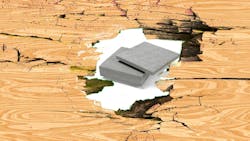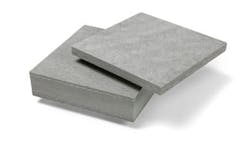Polyurethane Boards Replace Plywood in Structural and Non-structural Parts
This article was updated Jan. 2, 2022. It was originally published July 3, 2012.
RELATED
Surfboard Industry Not "Wiped Out" Yet
Where Foam Fits in Medical Design
Where Reticulated Polyurethane Foam's a Fit
Plywood and particle board have long been used for structural and non-structural parts, as well as cores for composite and molded parts. Unfortunately, both materials are prone to warping and rotting. To avoid those problems, engineers at 3M developed a reinforced polyurethane foam that can be supplied in sheets which are homogenous, stable and not susceptible to warping or rotting.
The lightweight sheets consist of closed-cell polyurethane with layers of continuous-strand fiberglass reinforcements embedded in it for strength. The sheets are also waterproof, so they cannot rot or warp and are well-suited for marine and transportation applications, as well as general construction.
Compared to plywood, the polyurethane foam boards have several advantages:
Lightweight: The foam boards weigh 30 to 60% less than the same sized plywood sheet. They are also stronger than similarly sized plywood boards.
Durability: The foam boards are waterproof and durable, so they should last for years. And unlike porous materials such as plywood and fabrics, the non-porous foam boards will not let moisture inside, which means mold will not grow on them.
Insulation: The foam has good insulative properties which translates into lower heating bills during colder months and less cooling needed during warmer days if it is used in housings, walls, ceilings or floors. This saves money over time without needing too much design work, if any.
Resists heat and chemicals: The foam boards can withstand temperatures up to 1,000°F. They also resist acids and petroleum products which makes them a good choice for automotive and construction-site applications.
Noise reduction: The polyurethane boards can reduce sound by more than 30%, which would be a major advantage in factories and other noisy environments.
Workability: The foam is easy to shape with tools and can be secured with screws, unlike plywood which can chip or come loose during construction. And their low moisture content makes it easier to secure them or to secure other components to them using adhesives.
The reinforced polyurethane foam from 3M is available as 4 × 8-ft sheets, which gives users a straight, level board that is easy to work. Users can choose between five densities ranging from 15 to 26 lb/ft3. For comparison, the density of plywood typically ranges from 30 to 43 lb/ft3.) Thicknesses can range from 5.1 to 15 in. (13 to 38 cm).

